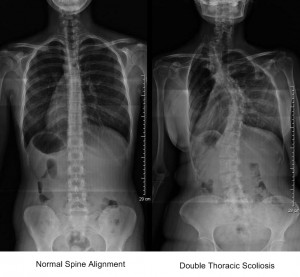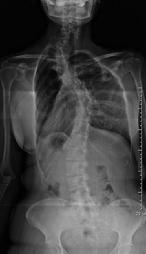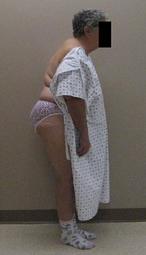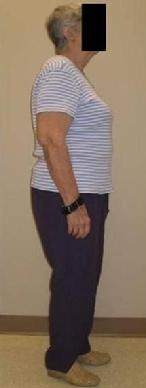Scoliosis and Kyphoscoliosis
 Scoliosis or Kyphoscoliosis is an abnormal alignment of the spine which can be seen in most age groups. The incidence of idiopathic scoliosis of more than 10 degrees are estimated to occure in 2-3% of children younger than 16 years old, and fewer than 10% of children with curves greater than 10 degree will require treatment. For scoliosis in adolescents, it is more common in girls, and tends to progress during the child’s growth spurts. Once growth stops, one can expect a curve less than 40% to also stop advancing.
Scoliosis or Kyphoscoliosis is an abnormal alignment of the spine which can be seen in most age groups. The incidence of idiopathic scoliosis of more than 10 degrees are estimated to occure in 2-3% of children younger than 16 years old, and fewer than 10% of children with curves greater than 10 degree will require treatment. For scoliosis in adolescents, it is more common in girls, and tends to progress during the child’s growth spurts. Once growth stops, one can expect a curve less than 40% to also stop advancing.
An example of kyphoscoliosis which is an abnormal forward (kyphosis) alignment of the spine would be a teenagers with Scheuermann Kyphosis (round back deformity of the upper back), or the elderly with progressive degenerative changes of the lumbar spine that has resulted in a loss of normal balance and posture.
This abnormal musculoskeletal alignment of the spine has an elusive cause in teenagers thus the name Idiopathic scoliosis. In our elderly population, it is typically related to the naturally progressive degenerative (arthritic) process, while those of us who are middle age may have a blend of both processes noted above consistent with a pre-existing idiopathic scoliosis which has now started to show signs of aging.
Classification Scoliosis is classified into a number of different categories which helps to predict patient prognosis, and treatment. These categories are based in part on the underlying disease process which may have influenced the cause, presents, or progression of the abnormal spinal curvature. The most common types of scoliosis include:
- Idiopathic Scoliosis
- Degenerative Scoliosis
- Neuromuscular Scoliosis
- Congenital Scoliosis
- Post-Traumatic Scoliosis
Treatment for Scoliosis
The treatment options available to patients with scoliosis depends on a number of factors which include but is not limited to scoliosis m
agnitude, the presents of active scoliosis progression, age of the patient, other symptoms such as back pain or leg pain, spine specific diagnosis such as stenosis, tumor, infections, herniated discs, degenerative arthritis, and finally the presents of other non-spine related conditions which may impact the patient’s ability to undergo surgery such as cardiac, renal, or pulmonary disease. The treatment options for scoliosis are very simple and can be summarized into three basic options:
- Observation
- Bracing
- Surgery
Most patients with scoliosis can be observed and will not require surgery. Bracing is only indicated for the young skeletally immature patient who is actively growing with a high risk curve for progression. Decisions on bracing are made by your orthopedic surgeon based on your child’s skeletal maturity, scoliosis magnitude, and location of the curves. The length of time in the brace will vary based on a number of parameters noted above. Bracing is not indicated in adults for the treatment of their curve but can be used for pain control for their degenerative arthropathy.
Not all surgeons who do spine work are trained to treat scoliosis and the vast majority of Scoliosis Surgeons are Orthopedic Surgeons who obtained additional training during their residency and completed a separate Orthopedic spine fellowship with particular attention on the diagnosis and treatment of patients with any of the above noted types of scoliosis.
Idiopathic Scoliosis
Previous scientific studies on idiopathic scoliosis painted a grim picture for those with scoliosis, often perpetuating the misconception that idiopathic scoliosis in children lead to disability as an adult from back pain and cardiopulmonary problems. The shortcomings of these original studies have been exposed as they often included more severe types of scoliosis (neuromuscular, congenital, etc) which carry an often more dramatic natural history and prognosis. The reality is that scoliosis in general does not predict future problems and only those rare scoliosis curves that progress if left untreated will lead to future issues. It is therefore very important that anyone who is suspected of having scoliosis be evaluated carefully by an Orthopedic Spine Surgeon. Prompt diagnosis, serial observation over a period of years, and timely treatment may prevent any future scoliosis related problems.
Degenerative Scoliosis
The major issue with degenerative scoliosis is the potential for progressive loss of normal posture. This can be a very disabling problem leaving the individual unable to stand up straight and maintain forward gaze (Normal horizontal line of sight), as well as a dramatic increase in oxygen and energy requirements. This increase in energy requirements by the patient increases almost on a linear basis with the larger the kyphosis magnitude. Stephen Ondra published in the Spine Journal in 2007 that patients with a 25 degree forward posture should expect a 25% increase in energy requirements and those patients with a 50 degree forward posture would see a 60% increase in energy demands just to walk and maintain normal activities of daily living. Having a forward posture like the woman demonstrated here is very disabling. Surgery for these patients will often reduce suffering and improve life style by allowing the individual to return to many activities of daily living that the rest of us take for granted. The vast majority of patients undergoing this extensive surgery to treat their degenerative kyphoscoliosis are very happy with their results. If you or a family member has scoliosis or is suffering from other spine conditions in the setting of scoliosis, a baseline examination with radiographs is important and will be followed with serial examination to watch for progression of the scoliosis in an effort to prevent future disability. Please contact our office if you have any further questions.




